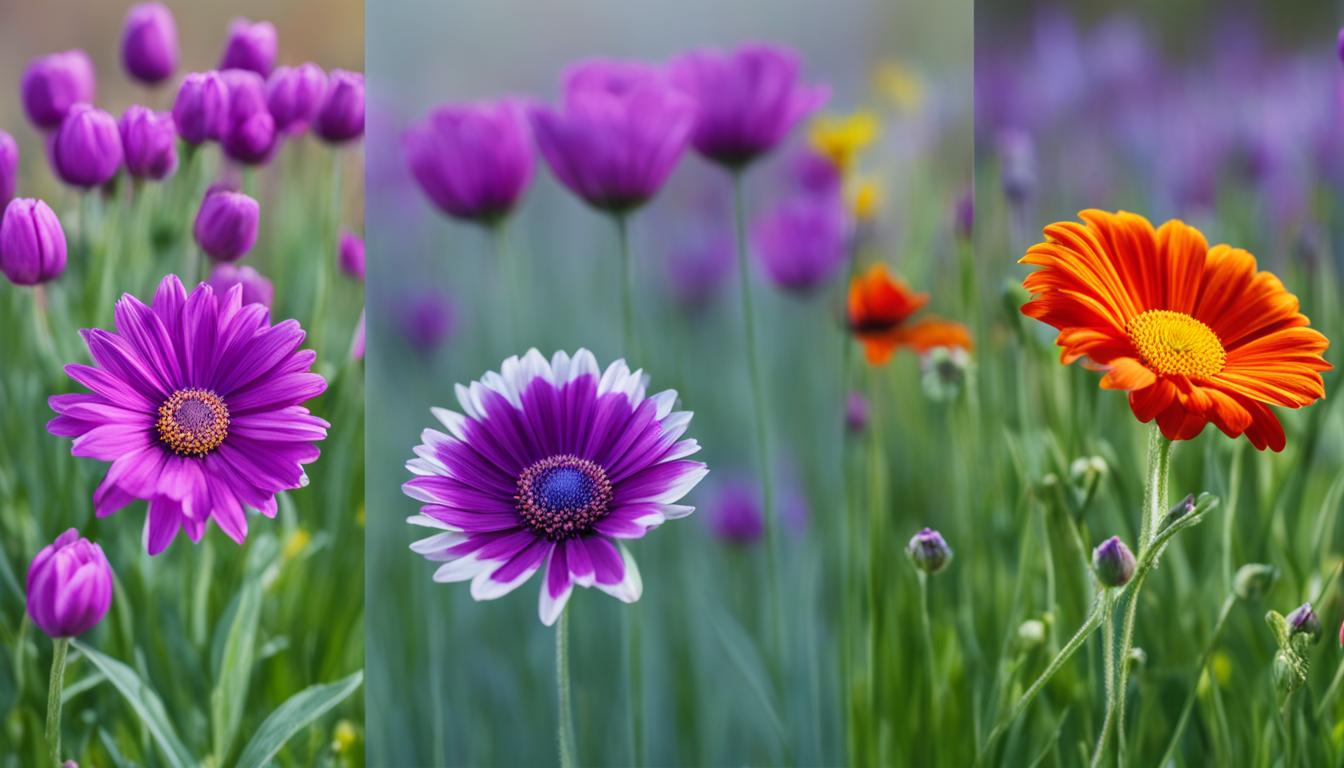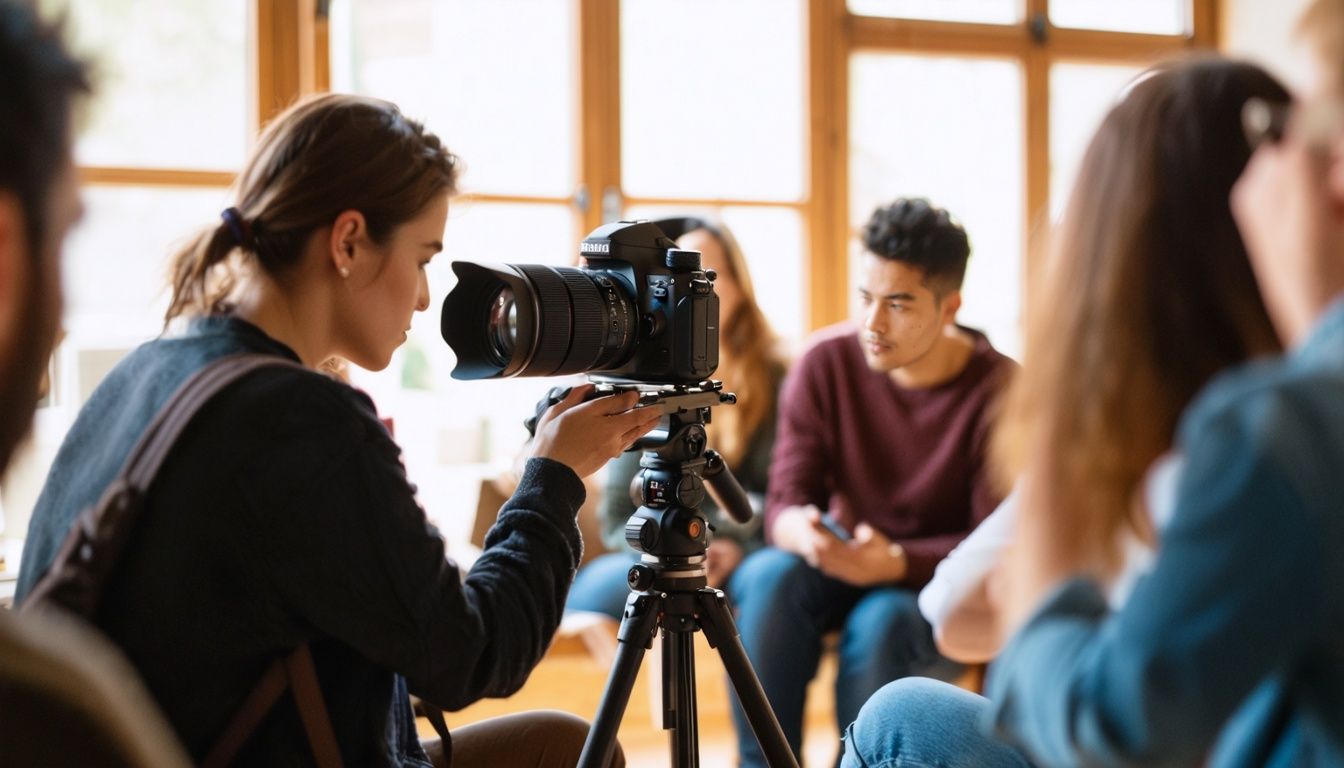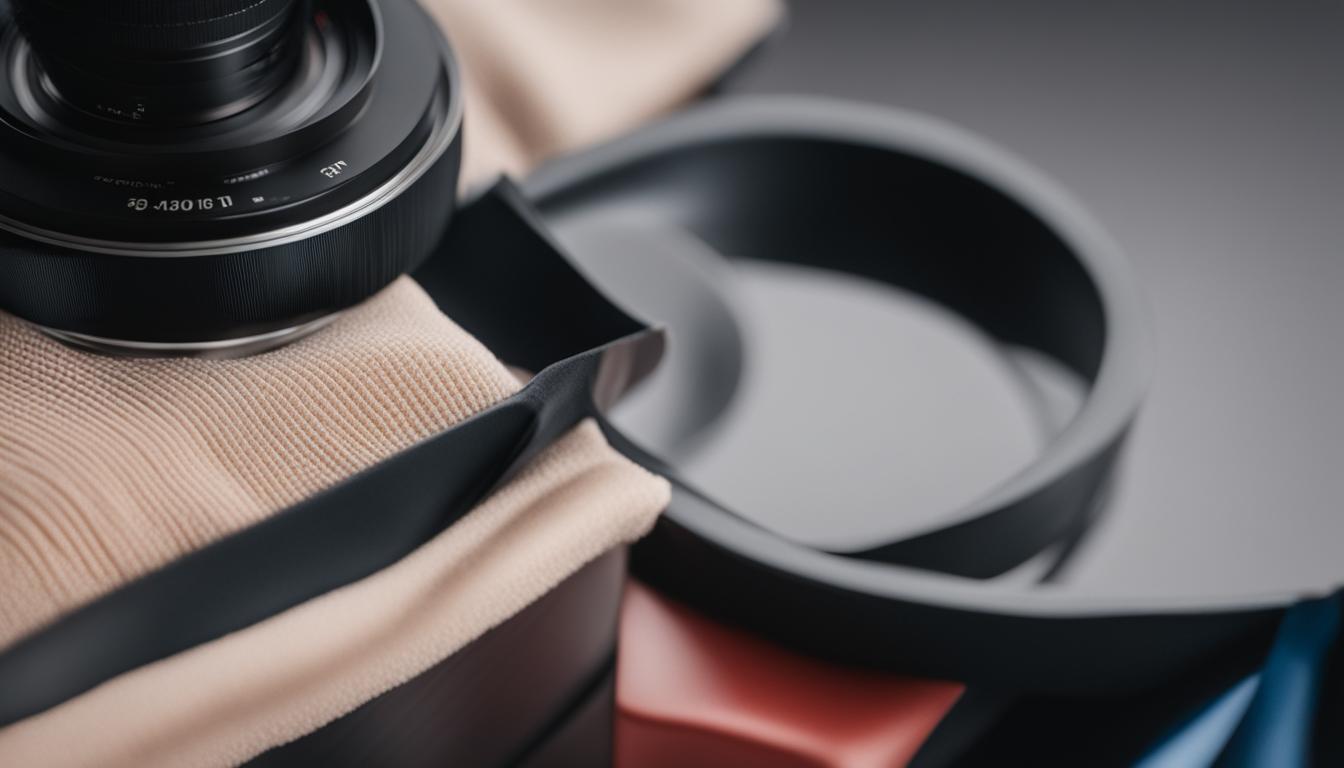Welcome to our guide on lens focal length and field of view! As photographers, understanding these fundamental concepts is essential for capturing the perfect shot. Lens focal length and field of view determine the angle of view, magnification, and the maximum area that can be captured by a camera. Let’s dive into the basics!
Key Takeaways:
- Focal length is the optical distance from the point where light converges to form a sharp image to the camera’s sensor or film.
- Zoom lenses have variable focal lengths, while prime lenses have fixed focal lengths.
- Wide-angle lenses have shorter focal lengths and capture a wider angle of view, while telephoto lenses have longer focal lengths and a narrower angle of view.
- The field of view is the maximum area that a camera can capture, measured in degrees.
- The choice of lens depends on the desired field of view, photography genre, and camera sensor size.
Lens Focal Length Comparison
When it comes to camera lenses, understanding the focal length is essential for capturing the perfect shot. Different lenses have varying focal lengths, each offering unique perspectives and capabilities. In this section, we will explore the lens focal length guide and the relationship between focal length and field of view.
Wide-angle Lenses
Recommended Focal Length: 10mm – 35mm
Wide-angle lenses have shorter focal lengths, typically ranging from 10mm to 35mm. These lenses excel in capturing expansive landscapes and confined spaces where you want to fit as much as possible into the frame. With their wider field of view, wide-angle lenses allow you to capture stunning panoramas and emphasize a sense of depth. They are perfect for outdoor photography and architectural shots.
Standard Lenses
Recommended Focal Length: Around 50mm
Standard lenses, often around 50mm, closely approximate the human field of view. These versatile lenses are a staple for various types of photography, including portraits, street photography, and everyday shooting. They produce images that closely resemble what the human eye sees, making them great for capturing the world around us with natural perspectives.
Telephoto Lenses
Recommended Focal Length: 70mm and above
Telephoto lenses have longer focal lengths, typically starting from 70mm and extending beyond. These lenses allow you to capture distant subjects with incredible detail and clarity. Whether you’re shooting wildlife, sports, or concerts, telephoto lenses bring your subject closer and help you isolate specific elements within the frame. They offer exceptional reach and minimal distortion, enabling you to capture stunning close-ups even from a distance.
Super Telephoto Lenses
Recommended Focal Length: Longer than 300mm
Super telephoto lenses take the concept of telephoto to another level, offering even longer focal lengths than their telephoto counterparts. Typically starting at 300mm and reaching up to extreme focal lengths, these lenses excel in capturing subjects that are incredibly far away. Super telephoto lenses are a favorite among wildlife photographers, sports enthusiasts, and astrophotographers who need exceptional magnification and telephoto compression.
Macro Lenses
Recommended Focal Length: 60mm – 200mm
Macro lenses are designed specifically for close-up photography of small subjects, such as flowers, insects, or jewelry. With focal lengths ranging from 60mm to 200mm, these lenses allow you to capture intricate details and produce stunning macro images. Macro lenses offer high magnification ratios, enabling you to explore the world of miniature photography and reveal captivating textures and patterns.
Now that we have explored the lens focal length guide, you can understand the distinctive characteristics and applications of different lens types. The focal length directly influences the perspective, angle of view, and magnification of your images. It’s important to consider your subject, shooting style, and artistic vision when selecting the appropriate lens for your photography needs.
Field of View Calculation
Understanding field of view is crucial for choosing the right lens for an embedded vision application. Field of view refers to the maximum area that a camera can capture, measured in degrees. To calculate the field of view, we use the angular field of view (AFOV) formula:
AFOV = 2 arctan (width of the object / (2 * focal length))
The width of the object seen through the lens and the working distance are taken into account when calculating the AFOV. Additionally, it’s possible to calculate the diagonal field of view (DFOV) and vertical field of view (VFOV) using the same formula, but replacing the width of the object with the respective values.
By understanding field of view and how to calculate it, we can make informed decisions about lens selection to ensure the desired coverage and composition for our embedded vision applications.

Example Calculation:
| Parameter | Value |
|---|---|
| Width of the object | 5 meters |
| Focal length | 50mm |
| AFOV | ? |
Let’s say we have an object with a width of 5 meters and our lens has a focal length of 50mm. Plugging these values into the AFOV formula, we can calculate the angular field of view:
AFOV = 2 arctan (5 / (2 * 50)) = 0.179 radians
Converting radians to degrees, we find that the AFOV is approximately 10.27 degrees. This means that our camera will capture a maximum field of view of 10.27 degrees with these specific parameters.
Focal Length Definition
In the world of camera lens fundamentals, understanding focal length is essential. Focal length refers to the distance between the optical center of the lens and the camera sensor. It is measured in millimeters and plays a crucial role in determining the angle of view and magnification of a lens.
When a lens focuses on an object at infinity, the resulting distance is known as the focal length. It is a defining property of the lens and is determined by factors such as the curvature and material of the lens.
Explaining focal length further, it is important to note that shorter focal lengths result in a wider angle of view, while longer focal lengths narrow the field of view. This means that lenses with shorter focal lengths can capture more of the scene in a single frame, perfect for landscape or group photography. On the other hand, lenses with longer focal lengths are ideal for zooming in on distant subjects, making them popular choices for wildlife or sports photography.
By understanding the concept of focal length, photographers can choose the right lens for their desired field of view and achieve their creative vision with precision and clarity.
Relationship between Focal Length and Field of View
Understanding the relationship between focal length and field of view is essential in photography. The focal length of a lens determines the angle of view, which directly affects how much of the scene can be captured in a photograph. In simple terms, the shorter the focal length, the wider the angle of view, and vice versa. This relationship can be mathematically expressed using the equation:
AFOV = 2 arctan (h / 2f)
where AFOV represents the angular field of view, h is the sensor size, and f is the focal length.
Let’s break down this equation to understand it better. The angular field of view is the extent of the scene that can be captured by the lens, expressed in degrees. The sensor size, h, refers to the dimensions of the camera sensor, typically measured in millimeters. Finally, the focal length, f, represents the distance between the lens and the camera sensor in millimeters.
Shorter focal lengths result in wider angles of view, allowing photographers to capture a broader scene. This is ideal for landscape photography, architectural shots, or any situation where you want to include more elements in the frame. On the other hand, longer focal lengths yield narrower angles of view, leading to a more zoomed-in perspective. Telephoto lenses with longer focal lengths are commonly used for wildlife photography, sports events, and other scenarios where the subject is farther away.
To illustrate the focal length and field of view relationship, let’s provide a visual representation:
| Focal Length (mm) | Angle of View |
|---|---|
| 24 | 84° |
| 50 | 46° |
| 100 | 24° |
| 200 | 12° |

In the table above, you can see the relationship between different focal lengths and their corresponding angles of view. As the focal length increases, the angle of view decreases, resulting in a narrower field of view.
Understanding this relationship is crucial for photographers as it allows for creative control over the composition and framing of a shot. By selecting the appropriate focal length, photographers can effectively capture the desired subject and include the desired amount of the surrounding environment.
Importance of Understanding Focal Length and Field of View
Understanding the relationship between focal length and field of view is essential when it comes to selecting the appropriate lens for photography or an embedded vision application. The choice of lens depends on the desired field of view and the camera sensor size.
Shorter focal lengths provide wider angles of view, allowing you to capture more of the scene in your frame. This is ideal for landscape photography or when you want to include more elements in your composition. On the other hand, longer focal lengths allow for more magnification and compression of distance. They are well-suited for capturing distant subjects with detail, making them popular for wildlife or sports photography.
By understanding the basics of camera lens fundamentals, photographers can make informed decisions about focal length and field of view to achieve their desired results.
The field of view is also influenced by the interaction between the focal length and the camera sensor. The size of the camera sensor affects the effective focal length, resulting in variations in the field of view. Full-frame camera sensors capture the full angle of view that the focal length can deliver, while crop sensors have a magnification factor that narrows down the field of view.
Having a good grasp of camera lens basics and understanding field of view allows photographers to have more control and creativity in their photography. It enables them to choose the right lens for specific scenes or to achieve a particular visual effect.
The Impact of Focal Length on Field of View
The relationship between focal length and field of view is worth exploring further. As the focal length of a lens increases, the angle of view narrows, resulting in a narrower field of view. Conversely, when the focal length decreases, the angle of view widens, leading to a wider field of view.
When it comes to understanding field of view, it’s important to comprehend the concept of angle of view. The angle of view is the amount of the scene that a lens can capture, measured in degrees. A wider angle of view captures more of the scene, while a narrower angle of view focuses on a smaller portion.
The angle of view can be calculated using the AFOV (angular field of view) formula: AFOV = 2 arctan (h / 2f), where AFOV is the angular field of view, h is the sensor size, and f is the focal length. This formula provides a mathematical understanding of how focal length affects the field of view.
In summary, understanding focal length and field of view is key to choosing the right lens for your photography needs. It allows you to capture the desired scene, control the level of magnification, and create the visual impact you envision.
Focal Length and Camera Sensor Size
The field of view in a photograph is influenced by the interaction between the focal length and the camera sensor size. The camera sensor plays a crucial role in capturing the image, while the focal length determines the angle of view and magnification of the lens.
Full-frame camera sensors are designed to accommodate the entire angle of view that the lens’s focal length can deliver. This means that the field of view captured by a full-frame sensor is true to the lens’s specifications.
Crop sensors, on the other hand, have a smaller surface area than full-frame sensors. This results in a magnification factor that affects the effective focal length of the lens. The image captured by a crop sensor camera is magnified, leading to a narrower field of view compared to full-frame cameras.
When choosing a lens, it is important to consider the camera sensor size to achieve the desired field of view. The combination of the lens’s focal length and the camera’s sensor size will determine how much of the scene will be captured in the final image.
Example
Let’s say we have a 50mm lens and two cameras, one with a full-frame sensor and one with a crop sensor. The full-frame camera will capture the scene with a field of view equivalent to a 50mm focal length. However, the crop sensor camera will magnify the image, resulting in a narrower field of view that may be closer to 75mm or 80mm (depending on the crop factor of the camera).
In the image above, you can see the comparison between a full-frame sensor and a crop sensor. The crop sensor captures a smaller portion of the scene, resulting in a narrower field of view.
Understanding the relationship between focal length and camera sensor size is essential in selecting the right lens to achieve the desired field of view for your photography needs.
Zoom vs Prime Lens
When it comes to choosing a lens for your camera, one of the key decisions you’ll face is whether to go for a zoom lens or a prime lens. Both options have their advantages and can greatly impact the outcome of your photographs. In this section, we’ll explore the differences between zoom lenses and prime lenses to help you make an informed choice.
Zoom Lenses
Zoom lenses are known for their versatility. These lenses have variable focal lengths, allowing you to adjust the focal length and capture different scenes without having to change lenses. This flexibility can be a game-changer, especially when you’re shooting in situations where you need to quickly switch between different perspectives.
Additionally, zoom lenses often cover a wide range of focal lengths, from wide-angle to telephoto. This means you can capture everything from expansive landscapes to distant subjects without needing to carry multiple lenses. It’s a great option for photographers who value convenience and want to be prepared for any situation.
However, it’s worth noting that zoom lenses tend to be larger and heavier than prime lenses. This can make them bulkier to carry around, especially if you’re shooting for long periods or traveling light. Additionally, zoom lenses often have smaller maximum apertures compared to prime lenses, which can affect low-light performance and depth of field control.
Prime Lenses
On the other hand, prime lenses have fixed focal lengths. These lenses are often smaller, lighter, and more compact than zoom lenses, making them a popular choice for photographers who prioritize portability and mobility. They are great for when you want to travel light or shoot for extended periods without feeling the weight of your gear.
Prime lenses also tend to have larger maximum apertures, allowing for better low-light performance and greater control over depth of field. The wider apertures enable you to achieve a shallow depth of field, creating a pleasing background blur and emphasizing the subject. This makes prime lenses a go-to choice for portrait and artistic photography.
However, the fixed focal length of prime lenses means you have to physically move closer or further away from your subject to adjust your composition. This can be challenging in fast-paced situations or when shooting distant subjects. Prime lenses require you to rely on your feet and compositional skills to capture the perfect shot.
In summary, the choice between a zoom lens and a prime lens ultimately depends on your personal preferences and the specific requirements of your photography. If you value versatility and convenience, a zoom lens might be the ideal choice. On the other hand, if you prioritize portability, low-light performance, and greater control over depth of field, a prime lens might be more suitable. Consider your shooting style, budget, and the type of photography you enjoy to make an informed decision.
Now, let’s take a look at a comparison table highlighting the key differences between zoom lenses and prime lenses:
| Zoom Lenses | Prime Lenses | |
|---|---|---|
| Variable Focal Length | Yes | No |
| Size and Weight | Usually larger and heavier | Smaller and lighter |
| Maximum Aperture | Often smaller | Often larger |
| Portability | Less portable | More portable |
| Depth of Field Control | Good | Great |
| Subject Distance | Can adjust without moving | Requires physical adjustment |
As you can see from the table, both zoom lenses and prime lenses have their respective strengths and weaknesses. Consider your shooting style, subject matter, and budget when making your decision. Remember, the right lens for your camera is the one that best suits your needs and helps you capture the images you envision.
Suggested Focal Lengths for Different Types of Photography
When it comes to photography, choosing the right focal length is essential to capture the desired effect and achieve optimal results. Different types of photography require specific focal lengths to bring out the best in your images. Let’s explore some suggested focal lengths for various genres:
Portraits:
For capturing stunning portraits, focal lengths around 50mm are commonly used. This range closely approximates the human field of view, resulting in natural-looking images that highlight the subject’s features and expressions.
Street photography:
To capture the bustling atmosphere of the streets and the candid moments of everyday life, focal lengths like 35mm or 50mm are often preferred. These focal lengths allow for a wider perspective, enabling photographers to capture both the subjects and the environment seamlessly.
Architecture photography:
When photographing architecture, ultrawide angle lenses with focal lengths in the range of 14-21mm are frequently used. These lenses help capture the grandeur and intricate details of buildings, providing a wider field of view without distortion.
Landscape photography:
Landscape photography offers the opportunity to explore a wide range of focal lengths depending on the desired effect. Wide-angle lenses with shorter focal lengths are ideal for capturing vast, sweeping landscapes, while telephoto lenses with longer focal lengths can be used to compress the distance and create a more intimate perspective. The choice between wide-angle and telephoto lenses depends on the specific composition and perspective you want to achieve.
Wildlife and sports photography:
For wildlife and sports photography, long telephoto lenses with focal lengths greater than 400mm are often necessary to capture distant subjects with clarity and precision. These lenses allow photographers to get up close and personal, bringing the action to life even from a distance.
It’s important to note that these suggested focal lengths can vary depending on personal preferences, shooting style, and the specific requirements of each photographer. Experimenting with different focal lengths will help you discover your own unique visual language and capture stunning images that tell a story.
| Genre | Suggested Focal Length |
|---|---|
| Portraits | Around 50mm |
| Street photography | 35mm or 50mm |
| Architecture photography | 14-21mm |
| Landscape photography | Wide-angle to telephoto, depending on desired effect |
| Wildlife and sports photography | Long telephoto lenses (>400mm) |
By understanding the suggested focal lengths for different types of photography, you can better equip yourself with the right lens to capture your vision and create captivating images that resonate with viewers.
Conclusion
Understanding the basics of camera lens focal length and field of view is essential for photographers and those working with embedded vision applications. Focal length plays a crucial role in determining the angle of view and magnification of a lens. It impacts the ability to capture a wide or narrow scene and can greatly influence the composition and perspective of a photograph.
On the other hand, field of view refers to the maximum area that a camera can capture. It encompasses everything that falls within the frame of the image and is influenced by the lens focal length and the camera sensor size. By understanding the relationship between focal length and field of view, photographers can make informed decisions when choosing the right lens for their specific needs and desired results.
Whether you are capturing breathtaking landscapes, intimate portraits, or fast-paced action, the choice of focal length will greatly impact the outcome of your images. It is important to consider the genre or application you are working with, as different types of photography may require specific focal lengths to achieve optimal results.
By grasping the fundamentals of camera lens basics and focal length explained, you can confidently navigate the world of lenses and make informed choices that best suit your creative vision. As you continue to explore the possibilities and experiment with different focal lengths and field of view, you will gain a deeper understanding of how these elements can elevate your photography and visual storytelling.
FAQ
What is the focal length of a lens?
The focal length is the optical distance from the point where light converges to form a sharp image to the camera’s sensor or film.
What is the field of view?
The field of view refers to the maximum area that a camera can capture.
How does focal length affect the angle of view?
The focal length of a lens determines the angle of view, with shorter focal lengths capturing a wider angle and longer focal lengths capturing a narrower angle.
What types of lenses have different focal lengths?
Wide-angle lenses have shorter focal lengths, telephoto lenses have longer focal lengths, and macro lenses have focal lengths for close-up photography.
How do I calculate the field of view?
The field of view can be calculated using the angular field of view (AFOV) formula, which takes into account the sensor size and focal length.
What is the relationship between focal length and field of view?
Focal length and field of view are directly related, with shorter focal lengths resulting in wider angles of view and longer focal lengths resulting in narrower angles of view.
Why is it important to understand focal length and field of view?
Understanding focal length and field of view is crucial for choosing the right lens for photography or an embedded vision application.
How does camera sensor size affect field of view?
Camera sensor size affects the field of view, with full-frame cameras capturing a wider angle compared to crop sensor cameras.
What is the difference between a zoom lens and a prime lens?
Zoom lenses have variable focal lengths, allowing for versatility, while prime lenses have fixed focal lengths and are often smaller and lighter.
What focal lengths are suitable for different types of photography?
Portraits often use focal lengths around 50mm, street photography benefits from 35mm or 50mm focal lengths, and architecture photography may utilize ultrawide angle lenses.
How Does Understanding White Balance and Color Temperature Relate to Understanding Lens Focal Length and Field of View?
Understanding white balance color temperature and understanding lens focal length and field of view are essential for achieving optimal color accuracy and composition in photography. White balance and color temperature affect the overall mood and tone of the image, while lens focal length and field of view determine the perspective and framing of the shot.




